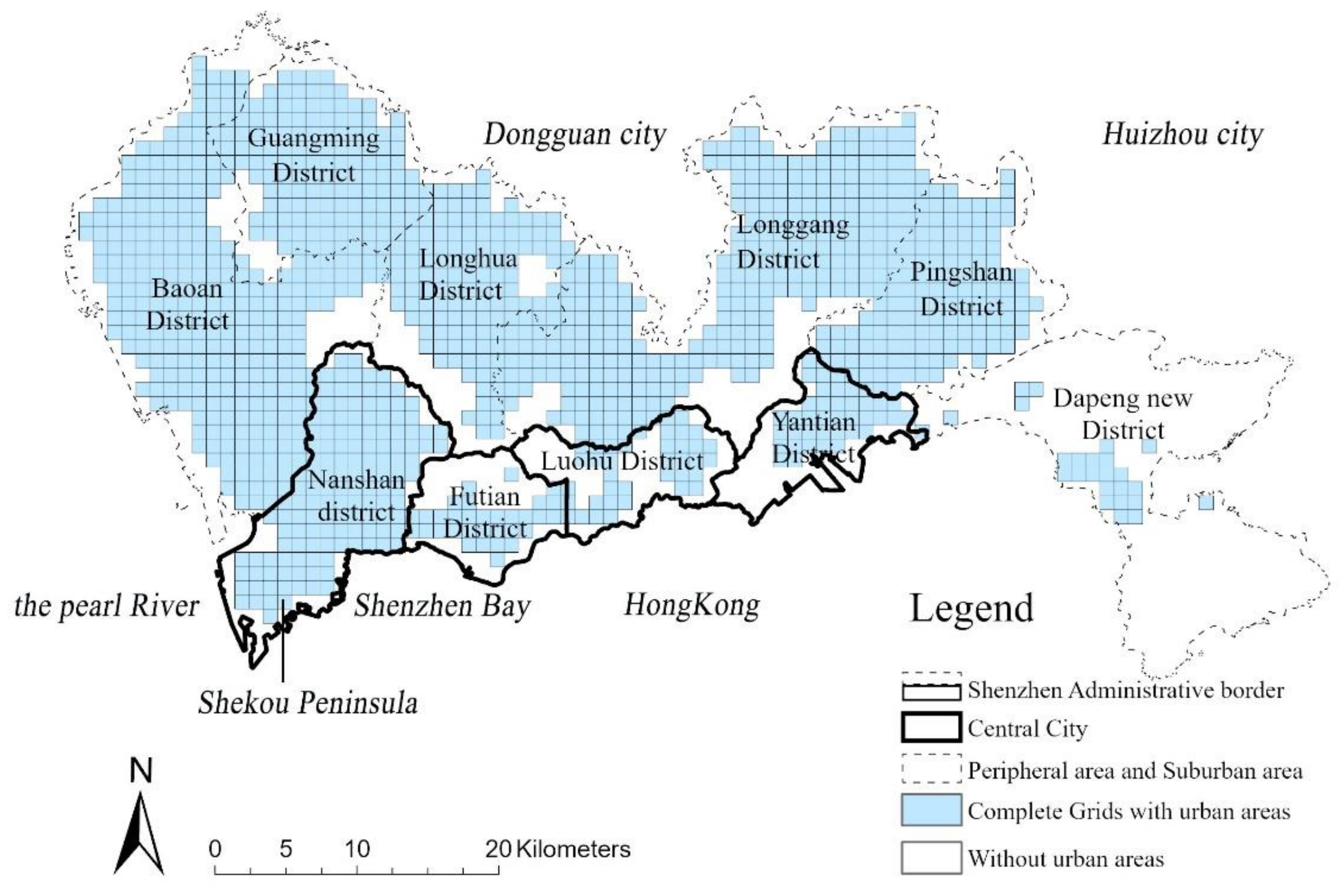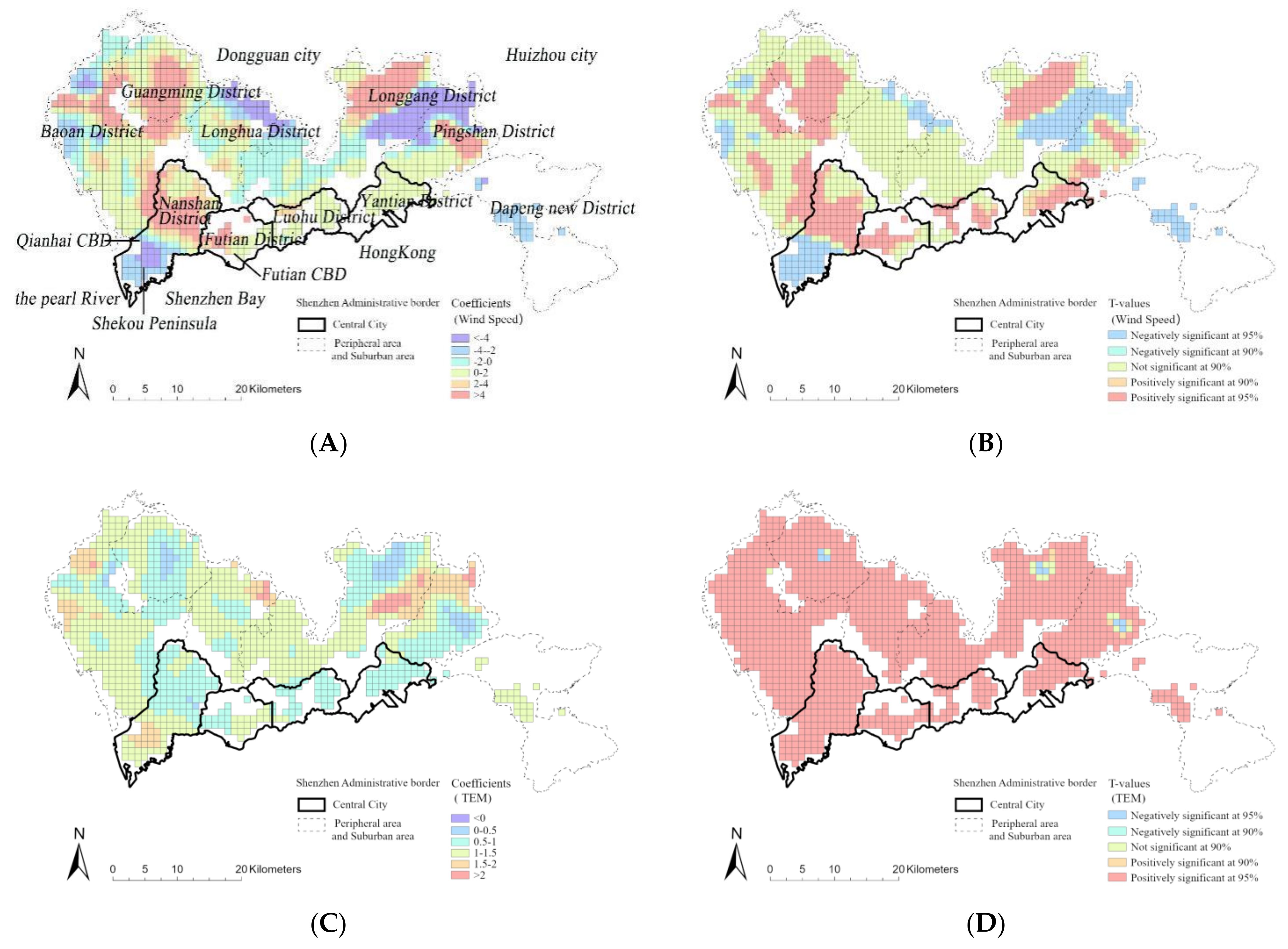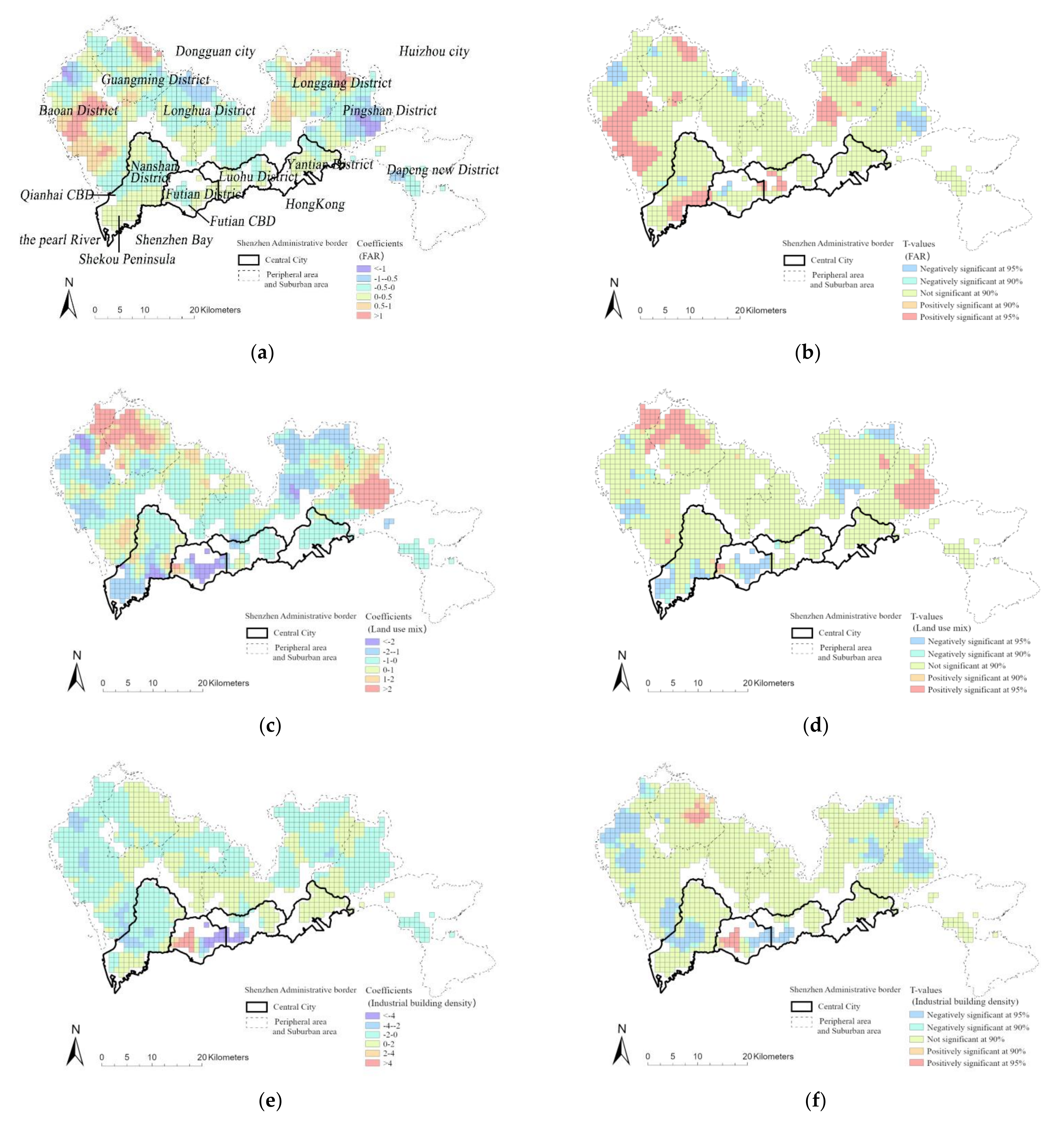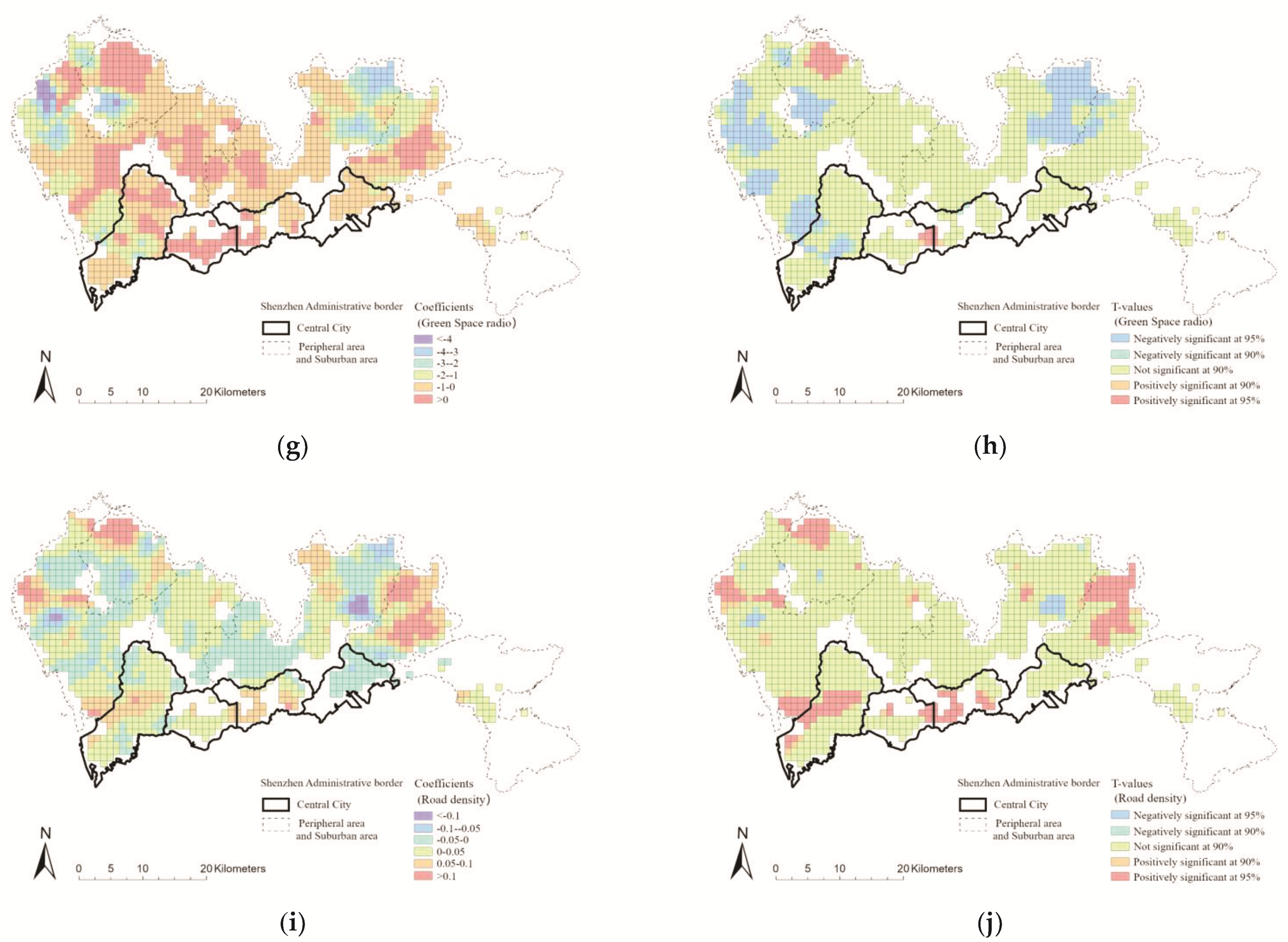Exploring the Joint Impacts of Natural and Built Environments on PM2.5 Concentrations and Their Spatial Heterogeneity in the Context of High-Density Chinese Cities
Abstract
:1. Introduction
2. Literature Review
3. Data and Methodology
3.1. Study Area and Data
3.2. The Global and Local Regression Models
4. Modeling Results and Discussion
4.1. OLS Results
4.2. GWR Results
5. Discussion
6. Conclusions and Policy Implications
Author Contributions
Funding
Institutional Review Board Statement
Informed Consent Statement
Data Availability Statement
Acknowledgments
Conflicts of Interest
References
- Wang, S.; Liu, X.; Yang, X.; Zou, B.; Wang, J. Spatial variations of PM2.5 in Chinese cities for the joint impacts of human activities and natural conditions: A global and local regression perspective. J. Clean. Prod. 2018, 203, 143–152. [Google Scholar] [CrossRef]
- Han, B.; Zhang, R.; Yang, W.; Bai, Z.; Ma, Z.; Zhang, W. Heavy haze episodes in Beijing during January 2013: Inorganic ion chemistry and source analysis using highly time-resolved measurements from an urban site. Sci. Total Environ. 2016, 544, 319–329. [Google Scholar] [CrossRef]
- Liu, Q.; Wu, R.; Zhang, W.; Li, W.; Wang, S. The varying driving forces of PM2.5 concentrations in Chinese cities: Insights from a geographically and temporally weighted regression model. Environ. Int. 2020, 145, 106168. [Google Scholar] [CrossRef] [PubMed]
- Zhang, Q.; Quan, J.; Tie, X.; Li, X.; Liu, Q.; Gao, Y.; Zhao, D. Effects of meteorology and secondary particle formation on visibility during heavy haze events in Beijing, China. Sci. Total Environ. 2015, 502, 578–584. [Google Scholar] [CrossRef]
- Yang, Q.; Yuan, Q.; Li, T.; Shen, H.; Zhang, L. The Relationships between PM2.5 and Meteorological Factors in China: Seasonal and Regional Variations. Int. J. Environ. Res. Public Health 2017, 14, 1510. [Google Scholar] [CrossRef] [Green Version]
- Yang, H.; Peng, Q.; Zhou, J.; Song, G.; Gong, X. The unidirectional causality influence of factors on PM2.5 in Shenyang city of China. Sci. Rep. 2020, 10, 8403. [Google Scholar] [CrossRef]
- Li, X.; Feng, Y.J.; Liang, H.Y. The Impact of Meteorological Factors on PM2.5 Variations in Hong Kong. In Iop Conference Series: Earth and Environmental Science, Proceedings of the 8th International Conference on Environmental Science and Technology (ICEST 2017), Madrid, Spain, 12–14 June 2017; IOP Publishing: Bristol, UK, 2017; Volume 78, p. 012003. [Google Scholar] [CrossRef]
- Zhang, Y.L.; Cao, F. Fine particulate matter (PM 2.5) in China at a city level. Sci. Rep. 2015, 5, 14884. [Google Scholar] [CrossRef] [PubMed] [Green Version]
- Zhang, F.; Cheng, H.-R.; Wang, Z.-W.; Lv, X.-P.; Zhu, Z.-M.; Zhang, G.; Wang, X.-M. Fine particles (PM2.5) at a CAWNET background site in Central China: Chemical compositions, seasonal variations and re-gional pollution events. Atmos. Environ. 2014, 86, 193–202. [Google Scholar] [CrossRef]
- Chen, Z.; Chen, D.; Zhao, C.; Kwan, M.P.; Cai, J.; Zhuang, Y.; Zhao, B.; Wang, X.; Chen, B.; Yang, J.; et al. Influence of meteorological conditions on PM2.5 concentrations across China: A review of methodology and mechanism. Environ. Int. 2020, 139, 105558. [Google Scholar] [CrossRef] [PubMed]
- Luo, M.; Hou, X.; Gu, Y.; Lau, N.C.; Yim, S.H. Trans-boundary air pollution in a city under various atmospheric conditions. Sci. Total Environ. 2018, 618, 132–141. [Google Scholar] [CrossRef] [PubMed]
- Zhang, H.; Wang, Y.; Hu, J.; Ying, Q.; Hu, X.M. Relationships between meteorological parameters and criteria air pollutants in three megacities in China. Environ. Res. 2015, 140, 242–254. [Google Scholar] [CrossRef]
- Li, W.; Liu, X.; Zhang, Y.; Sun, K.; Wu, Y.; Xue, R.; Zeng, L.; Qu, Y.; An, J. Characteristics and formation mechanism of regional haze episodes in the Pearl River Delta of China. J. Environ. Sci. (China) 2018, 63, 236–249. [Google Scholar] [CrossRef]
- Guo, L.C.; Zhang, Y.; Lin, H.; Zeng, W.; Liu, T.; Xiao, J.; Rutherford, S.; You, J.; Ma, W. The washout effects of rainfall on atmospheric particulate pollution in two Chinese cities. Environ. Pollut. 2016, 215, 195–202. [Google Scholar] [CrossRef]
- Zhang, Z.; Zhang, X.; Gong, D.; Quan, W.; Zhao, X.; Ma, Z.; Kim, S.-J. Evolution of surface O3 and PM2.5 concentrations and their relationships with meteorological conditions over the last decade in Beijing. Atmos. Environ. 2015, 108, 67–75. [Google Scholar] [CrossRef]
- Qiu, D.; Liu, J.; Zhu, L.; Mo, L.; Zhang, Z. Particulate matter assessment of a wetland in Beijing. J. Environ. Sci. (China) 2015, 36, 93–101. [Google Scholar] [CrossRef]
- Yuan, S.; Xu, W.; Liu, Z. A Study on the Model for Heating Influence on PM2.5 Emission in Beijing China. Procedia Eng. 2015, 121, 612–620. [Google Scholar] [CrossRef] [Green Version]
- Li, Y.; Chen, Q.; Zhao, H.; Wang, L.; Tao, R. Variations in Pm10, PM2.5 and PM1.0 in an Urban Area of the Sichuan Basin and Their Relation to Meteorological Factors. Atmosphere 2015, 6, 150–163. [Google Scholar] [CrossRef] [Green Version]
- Du, Y.; Wan, Q.; Liu, H.; Liu, H.; Kapsar, K.; Peng, J. How does urbanization influence PM2.5 concentrations? Perspective of spillover effect of multi-dimensional urbanization impact. J. Clean. Prod. 2019, 220, 974–983. [Google Scholar] [CrossRef]
- Lim, C.H.; Ryu, J.; Choi, Y.; Jeon, S.W.; Lee, W.K. Understanding global PM2.5 concentrations and their drivers in recent decades (1998–2016). Environ. Int. 2020, 144, 106011. [Google Scholar] [CrossRef]
- Zhang, Z.; Shao, C.; Guan, Y.; Xue, C. Socioeconomic factors and regional differences of PM2.5 health risks in China. J. Environ. Manag. 2019, 251, 109564. [Google Scholar] [CrossRef] [PubMed]
- Wu, J.; Zhang, P.; Yi, H.; Qin, Z. What Causes Haze Pollution? An Empirical Study of PM2.5 Concentrations in Chinese Cities. Sustainability 2016, 8, 132. [Google Scholar] [CrossRef] [Green Version]
- Yuan, M.; Song, Y.; Huang, Y.; Shen, H.; Li, T. Exploring the association between the built environment and remotely sensed PM2.5 concentrations in urban areas. J. Clean. Prod. 2019, 220, 1014–1023. [Google Scholar] [CrossRef]
- Yuan, M.; Song, Y.; Hong, S.; Huang, Y. Evaluating the effects of compact growth on air quality in already-high-density cities with an integrated land use-transport-emission model: A case study of Xiamen, China. Habitat Int. 2017, 69, 37–47. [Google Scholar] [CrossRef]
- Zhou, S.; Lin, R. Spatial-temporal heterogeneity of air pollution: The relationship between built environment and on-road PM2.5 at micro scale. Transp. Res. Part D: Transp. Environ. 2019, 76, 305–322. [Google Scholar] [CrossRef]
- Park, S.-H.; Ko, D.-W. Investigating the Effects of the Built Environment on PM2.5 and PM10: A Case Study of Seoul Metropolitan City, South Korea. Sustainability 2018, 10, 4552. [Google Scholar] [CrossRef] [Green Version]
- Lee, C. Impacts of multi-scale urban form on PM2.5 concentrations using continuous surface estimates with high-resolution in U.S. metropolitan areas. Landsc. Urban Plan. 2020, 204, 103935. [Google Scholar] [CrossRef]
- Tainio, M.; De Nazelle, A.J.; Gotschi, T.; Kahlmeier, S.; Rojas-Rueda, D.; Nieuwenhuijsen, M.J.; De Sa, T.H.; Kelly, P.; Woodcock, J. Can air pollution negate the health benefits of cycling and walking? Prev. Med. 2016, 87, 233–236. [Google Scholar] [CrossRef] [PubMed] [Green Version]
- Stevenson, M.; Thompson, J.; De Sá, T.H.; Ewing, R.; Mohan, D.; Mcclure, R.; Roberts, I.; Tiwari, G.; Giles-Corti, B.; Sun, X.; et al. Land use, transport, and population health: Estimating the health benefits of compact cities. Lancet 2016, 388, 2925–2935. [Google Scholar] [CrossRef] [Green Version]
- Zhao, P.; Li, S.; Li, P.; Liu, J.; Long, K. How does air pollution influence cycling behaviour? Evidence from Beijing. Transp. Res. Part D: Transp. Environ. 2018, 63, 826–838. [Google Scholar] [CrossRef]
- Anowar, S.; Eluru, N.; Hatzopoulou, M. Quantifying the value of a clean ride: How far would you bicycle to avoid exposure to traffic-related air pollution? Transp. Res. Part A Policy Pract. 2017, 105, 66–78. [Google Scholar] [CrossRef]
- Fan, X.; Lam, K.C.; Yu, Q. Differential exposure of the urban population to vehicular air pollution in Hong Kong. Sci. Total Environ. 2012, 426, 211–219. [Google Scholar] [CrossRef]
- De Nazelle, A.; Rodriguez, D.A.; Crawford-Brown, D. TThe built environment and health: Impacts of pedestrian-friendly designs on air pollution exposure. Sci. Total Environ. 2009, 407, 2525–2535. [Google Scholar] [CrossRef] [PubMed]
- Tainio, M.; Jovanovic Andersen, Z.; Nieuwenhuijsen, M.J.; Hu, L.; De Nazelle, A.; An, R.; Garcia, L.M.T.; Goenka, S.; Zapata-Diomedi, B.; Bull, F.; et al. Air pollution, physical activity and health: A mapping review of the evidence. Environ. Int. 2021, 147, 105954. [Google Scholar] [CrossRef]
- Li, C.; Song, Y.; Tian, L.; Ouyang, W. Urban Form, Air Quality, and Cardiorespiratory Mortality: A Path Analysis. Int. J. Environ. Res. Public Health 2020, 17, 1202. [Google Scholar] [CrossRef] [PubMed] [Green Version]
- Huang, L.; Zhang, C.; Bi, J. Development of land use regression models for PM2.5, SO2, NO2 and O3 in Nanjing, China. Environ. Res. 2017, 158, 542–552. [Google Scholar] [CrossRef] [PubMed]
- Liu, C.; Henderson, B.H.; Wang, D.; Yang, X.; Peng, Z.R. A land use regression application into assessing spatial variation of intra-urban fine particulate matter (PM2.5) and nitrogen dioxide (NO2) concentrations in City of Shanghai, China. Sci. Total Environ. 2016, 565, 607–615. [Google Scholar] [CrossRef]
- Hao, Y.; Liu, Y.-M. The influential factors of urban PM2.5 concentrations in China: A spatial econometric analysis. J. Clean. Prod. 2016, 112, 1443–1453. [Google Scholar] [CrossRef]
- Chen, M.; Dai, F.; Yang, B.; Zhu, S. Effects of neighborhood green space on PM2.5 mitigation: Evidence from five megacities in China. Building and Environment. Build. Environ. 2019, 156, 33–45. [Google Scholar] [CrossRef]
- Zhou-Ning, Y.; Jingfeng, M.; Yan, Y.; Shu-Yuan, Y.; Bin, L. Pollution status and source apportionment of atmospheric particulates(PM2.5) in Shenzhen city. Pract. Prev. Med. 2019, 26, 1172–1176. [Google Scholar]
- Liu, Q.; Ding, C.; Chen, P. A panel analysis of the effect of the urban environment on the spatiotemporal pattern of taxi demand. Travel Behaviour and Society 2020, 18, 29–36. [Google Scholar] [CrossRef]
- Lin, G.; Fu, J.; Jiang, D.; Wang, J.; Wang, Q.; Dong, D. Spatial Variation of the Relationship between PM 2.5 Concentrations and Meteorological Parameters in China. Biomed. Res. Int. 2015, 2015, 684618. [Google Scholar] [CrossRef] [PubMed]




| Variables | Unit | Year | Average | Min | Max | St.Dev | Specifications | ||
|---|---|---|---|---|---|---|---|---|---|
| Dependent Variables | PM2.5 concentration | μg/m3 | 2016 | 25.99 | 20.2 | 32.2 | 2.50 | PM2.5 concentration data were from NASA; resolution: 0.01 longitude (1 km × 1 km) | |
| Independent Variables | FAR | M2/m2 | 2018 | 0.90 | 0.00 | 7.30 | 0.97 | Data source: Shenzhen Government Data Open Platform published building census data in 2018. FAR is the radio of the total building area to the land area in each research unit, and it is an important index to measure the intensity of land development. | |
| Road density | km/km2 | 2018 | 8.49 | 0.00 | 33.51 | 6.50 | Summarize and calculate the total length of various urban roads on each square kilometer of urban land and calculate the length density of the road network of each grid. | ||
| Land use mix degree | % | 2018 | 0.39 | 0.00 | 0.83 | 0.22 | Land use mixing degree refers to the overall situation of mixed use of different land use types in the research unit. Using Entropy method to calculate the mixing degree of land in each grid. Entropy index (ENT) =− be the percentage of each land use type j in the area, and let be the number of land use types j. | ||
| Industrial building ratio | % | 2018 | 0.27 | 0.00 | 1.00 | 0.27 | Count the total area of industrial buildings per square kilometer and calculate the radio of industrial building area. | ||
| Bus station density | number/km2 | 2015 | 4.49 | 1.00 | 21.00 | 3.82 | According to the distribution data of bus stations in Shenzhen, calculate the number of bus stations per square kilometer. | ||
| Travel time index | - | 2016 | 2.81 | 0.70 | 4.88 | 0.82 | Traffic index is a comprehensive index that uses GPS floating car technology and fuses multisource data to quantitatively evaluate the overall operation status of road network traffic. TTI: in the same link in a time slice, TTI = free stream speed/actual speed. , , The total number of link is N, Li is the lenght of links Wi is the weight of links is the free flow speed of links and Vi is the real time road speed of links. | ||
| Green space rate | % | 2015 | 2.81 | 0.70 | 4.88 | 0.82 | Based on the remote sensing data of Shenzhen, the green space area per square kilometer of land is screened out, and the proportion of green space is calculated. | ||
| TEM | °C | 2020 | 23.13 | 21.35 | 23.83 | 0.49 | Data source: the data released by Meteorological Bureau of Shenzhen Municipality in 2020. Temporal interval: 7:00 AM–9:00 AM and 17:30 PM–19:30 PM | Calculate the average temperature during the peak travel hours every day in 2020. The more solar radiation there is, the higher the temperature is. Generally, it refers to the temperature in the louver at a height of approximately 1.5 m on the ground. | |
| RH | ° | 2020 | 60.50 | 43.40 | 83.18 | 6.58 | Mass of water vapor per unit volume of air using relative humidity. | ||
| WS | m/s | 2020 | 1.71 | 1.10 | 2.74 | 0.33 | Wind speed is the movement rate of air relative to a fixed place on the Earth and the wind speed in various regions of Shenzhen during peak hours. | ||
| Variables | Normalization Coefficient | Nonnormalization Coefficient | t-Value | p-Value | VIF |
|---|---|---|---|---|---|
| Intercept | 0.000 | −62.609 | −26.368 | 0.000 * | - |
| Wind speed | 0.244 | 1.877 | 14.100 | 0.000 * | 1.163 |
| Temperature | 0.734 | 3.728 | 39.186 | 0.000 * | 1.359 |
| Relative humdity | −0.014 | −0.005 | −0.831 | 0.406 | 1.132 |
| FAR | −0.055 | −0.141 | −1.996 | 0.046 * | 2.956 |
| Land use mix | −0.077 | −0.876 | −3.302 | 0.001 * | 2.089 |
| Bus station density | 0.026 | 0.017 | 1.056 | 0.291 | 2.417 |
| Industrial building ratio | 0.060 | 0.562 | 3.348 | 0.001 * | 1.256 |
| Green space rate | −0.195 | −1.583 | −7.244 | 0.000 * | 2.816 |
| Road density | 0.056 | 0.021 | 1.778 | 0.076 * | 3.802 |
| TTI | 0.025 | 0.77 | 1.339 | 0.181 | 1.381 |
| Number of observations | 1235 | ||||
| AICc | 4367.374 | ||||
| Joint F-statistic | 265.412 | ||||
| Joint Wald statistic | 22702.541 | ||||
| Koenker (BP) statistic | 247.000 | ||||
| Jarque-Bera statistic | 107.572 | ||||
| R2 | 0.684 | ||||
| Adjusted R2 | 0.682 | ||||
| Moran’s I summary | |||||
| Moran’s Index | 0.654 | ||||
| Expected Index | −0.000 | ||||
| Variance | 0.000 | ||||
| z-score | 102.020 | ||||
| p-value | 0.000 | ||||
| Comparison | R2 | Adjusted R2 | AICc | |||
|---|---|---|---|---|---|---|
| OLS | 0.684 | 0.682 | 4367.374 | |||
| GWR | 0.967 | 0.950 | 2463.943 | |||
| Variables | Min | Median | Mean | Max | Positive | Negative |
| Wind speed | −23.459 | 0.796 | 0.856 | 16.552 | 33.85% | 16.60% |
| TEM | 0.002 | 1.047 | 1.078 | 2.941 | 98.22% | 0.00% |
| FAR | −2.872 | 0.004 | 0.072 | 2.334 | 18.54% | 6.32% |
| Land use mix | −5.646 | −0.154 | −0.034 | 5.251 | 12.15% | 10.53% |
| Industrial building density | −7.644 | −0.144 | −0.330 | 12.230 | 3.00% | 18.30% |
| Green space rate | −11.565 | −0.458 | −0.665 | 2.472 | 3.00% | 21.70% |
| Road density | −0.195 | 0.010 | 0.019 | 0.168 | 17.57% | 1.94% |
| Diagnostic information | ||||||
| Degree of freedom (residual:n-2trace(S)+trace(S’S)) | 815.626 | |||||
| ML 1 based sigma estimate | 0.456 | |||||
| Unbiased sigma estimate | 0.561 | |||||
| Classic AIC 2 | 2223.134 | |||||
| AICc | 2463.943 | |||||
| BIC/MDL 3 | 3909.828 | |||||
| CV 4 | 0.406 | |||||
| R2 | 0.967 | |||||
| Adjusted R2 | 0.950 | |||||
| Moran’s I summary | ||||||
| Moran’s Index | 0.030 | |||||
| Expected Index | −0.001 | |||||
| Variance | 0.000 | |||||
| z-score | 4.862 | |||||
| p-value | 0.000 | |||||
| Independent Variables | Negatively Significant at 95% | Negatively Significant at 90% | Not Significant | Positively Significant at 90% | Positively Significant at 95% |
|---|---|---|---|---|---|
| Wind speed | 15.30% | 1.30% | 49.55% | 3.81% | 30.04% |
| TEM | 0.00% | 0.00% | 1.78% | 0.40% | 97.81% |
| FAR | 4.13% | 2.19% | 75.14% | 2.35% | 16.19% |
| Land use mix | 6.72% | 3.81% | 77.33% | 2.19% | 9.96% |
| Industrial building density | 13.36% | 4.96% | 78.70% | 1.30% | 1.70% |
| Green space rate | 17.41% | 4.29% | 75.30% | 0.57% | 2.43% |
| Road density | 1.46% | 0.49% | 80.49% | 3.32% | 14.25% |
Publisher’s Note: MDPI stays neutral with regard to jurisdictional claims in published maps and institutional affiliations. |
© 2021 by the authors. Licensee MDPI, Basel, Switzerland. This article is an open access article distributed under the terms and conditions of the Creative Commons Attribution (CC BY) license (https://creativecommons.org/licenses/by/4.0/).
Share and Cite
Duan, S.; Liu, Q.; Jiang, D.; Jiang, Y.; Lin, Y.; Gong, Z. Exploring the Joint Impacts of Natural and Built Environments on PM2.5 Concentrations and Their Spatial Heterogeneity in the Context of High-Density Chinese Cities. Sustainability 2021, 13, 11775. https://doi.org/10.3390/su132111775
Duan S, Liu Q, Jiang D, Jiang Y, Lin Y, Gong Z. Exploring the Joint Impacts of Natural and Built Environments on PM2.5 Concentrations and Their Spatial Heterogeneity in the Context of High-Density Chinese Cities. Sustainability. 2021; 13(21):11775. https://doi.org/10.3390/su132111775
Chicago/Turabian StyleDuan, Shanyou, Qian Liu, Dumei Jiang, Yulin Jiang, Yinzhi Lin, and Ziying Gong. 2021. "Exploring the Joint Impacts of Natural and Built Environments on PM2.5 Concentrations and Their Spatial Heterogeneity in the Context of High-Density Chinese Cities" Sustainability 13, no. 21: 11775. https://doi.org/10.3390/su132111775
APA StyleDuan, S., Liu, Q., Jiang, D., Jiang, Y., Lin, Y., & Gong, Z. (2021). Exploring the Joint Impacts of Natural and Built Environments on PM2.5 Concentrations and Their Spatial Heterogeneity in the Context of High-Density Chinese Cities. Sustainability, 13(21), 11775. https://doi.org/10.3390/su132111775





